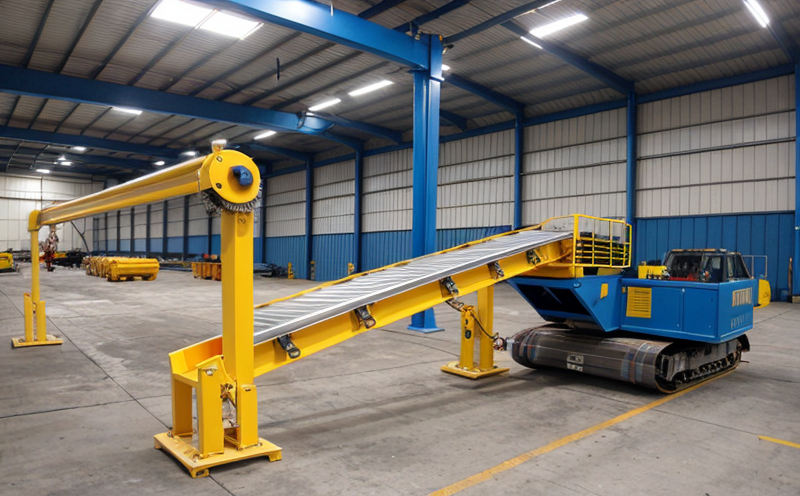ISO 14890 Conveyor Belt Cover Thickness Testing
The ISO 14890 standard is a critical benchmark in the mining industry for ensuring conveyor belt cover thickness. This testing procedure plays an essential role in safeguarding machinery and personnel safety, optimizing operational efficiency, and extending the lifespan of conveyor belts. The standards are designed to ensure that belts meet the required thickness specifications as defined by international norms.
The primary focus of ISO 14890 is on the mechanical properties of conveyor belt covers, particularly their resistance to abrasion and tear. Testing these aspects helps mining companies maintain optimal operating conditions in harsh environments where conveyor belts are exposed to abrasive materials and continuous stress. By adhering to this standard, mines can significantly reduce downtime due to unexpected equipment failures, thereby enhancing overall operational reliability.
Conveyor belt cover thickness testing involves precise measurement techniques that ensure accuracy and repeatability. The test typically requires the use of an appropriate gauge or micrometer capable of measuring small increments accurately. Specimen preparation is crucial; specimens should be cut from the actual conveyor belt to reflect real-world conditions, ensuring accurate representation.
The procedure outlined in ISO 14890 specifies detailed steps for testing, including sample selection, measurement points, and calculation methods. Compliance officers and quality managers must ensure that each step adheres strictly to these guidelines to guarantee consistent results across different batches or suppliers. This standard also includes provisions for handling anomalies such as variations in belt thickness, which can be attributed to manufacturing processes or environmental factors.
Accurate testing of conveyor belt cover thickness is not just about meeting regulatory requirements; it’s about preventing costly downtime and ensuring safe operations. In mining environments, where conveyor belts often carry heavy loads over long distances, even slight deviations from the specified thickness could lead to premature failures. Regular inspections and adherence to ISO 14890 help maintain optimal belt performance, reducing maintenance costs and improving safety standards.
Understanding the implications of non-compliance with ISO 14890 is equally important for R&D engineers and procurement specialists involved in material selection and supplier evaluations. Non-conformance can result in compromised equipment integrity, increased risk of accidents, and higher operational expenses. Therefore, integrating this standard into procurement strategies ensures that only high-quality materials are procured and used within the mine.
Implementing ISO 14890 testing protocols also contributes to broader industrial standards. By ensuring consistent quality across all components of conveyor systems, mining facilities can contribute positively to industry-wide best practices. This alignment helps promote a culture of excellence in maintenance and operational procedures, ultimately leading to more efficient and safer operations.
In conclusion, ISO 14890 is vital for maintaining the integrity of conveyor belts in mining environments. Its role extends beyond compliance; it serves as a cornerstone for enhancing safety, reliability, and sustainability across all aspects of conveyors used within mines. As such, rigorous adherence to this standard should be considered an essential practice for any mine looking to achieve peak performance from its conveyor systems.
Quality and Reliability Assurance
To ensure the highest levels of quality and reliability in conveyor belt cover thickness testing, our laboratory employs advanced equipment and methodologies. Our state-of-the-art facilities are equipped with precision micrometers and other specialized tools designed specifically for measuring thin materials like conveyor belts.
- We utilize high-precision instruments that meet or exceed the accuracy requirements specified by ISO 14890.
- Our team of certified technicians performs tests according to rigorous protocols, ensuring consistent results across all samples.
Our approach emphasizes not only precision but also repeatability. By maintaining strict adherence to international standards such as ISO 14890, we can provide accurate measurements that are reliable and repeatable under various conditions. This consistency is crucial for mining companies who rely on conveyor belts to operate safely and efficiently.
In addition to technical expertise, our laboratory offers a range of support services aimed at helping clients achieve their quality goals. From initial consultation through final analysis, we offer comprehensive guidance tailored specifically to the needs of each client. Whether you need assistance selecting appropriate samples or interpreting test results, our team is here to help every step of the way.
We also provide detailed reports that summarize all aspects of the testing process, including any deviations from specified limits and recommendations for corrective actions where necessary. These reports serve as valuable tools for quality managers and compliance officers looking to make data-driven decisions about their conveyor belt maintenance programs.
Customer Impact and Satisfaction
- Mining companies benefit from enhanced operational reliability, reduced maintenance costs, and improved safety standards when they follow ISO 14890 guidelines.
- Customers gain peace of mind knowing that their conveyor belts meet stringent international standards, which translates to better business outcomes.
We are committed to exceeding customer expectations by providing accurate, reliable test results on time. This commitment is reflected in our consistently high satisfaction rates among clients who rely on us for critical quality assurance services.
Environmental and Sustainability Contributions
- Incorporating ISO 14890 into your operations helps minimize waste by ensuring belts are replaced only when absolutely necessary, reducing unnecessary resource consumption.
- Our rigorous testing processes contribute to overall sustainability efforts within the mining sector by promoting efficient use of materials and resources.
We actively participate in environmental initiatives aimed at improving industry practices. By adhering strictly to ISO 14890 standards, we help promote sustainable development goals while ensuring safe, reliable conveyors for our clients.





